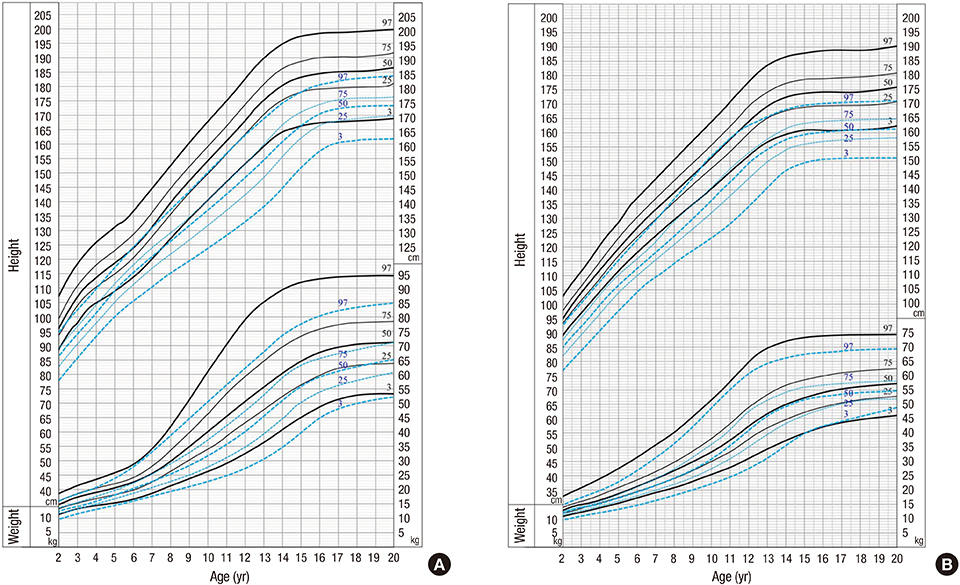J Korean Med Sci.
2015 Jul;30(7):911-916. 10.3346/jkms.2015.30.7.911.
Disease-specific Growth Charts of Marfan Syndrome Patients in Korea
- Affiliations
-
- 1Department of Pediatrics, Samsung Medical Center, Sungkyunkwan University School of Medicine, Seoul, Korea. jindk@skku.edu
- 2Department of Pediatrics, Myongji Hospital, Goyang, Korea.
- 3Department of Pediatrics, Graduate School of Medicine, The University of Tokyo, Tokyo, Japan.
- 4Department of Obstetrics and Gynecology, Samsung Medical Center, Sungkyunkwan University School of Medicine, Seoul, Korea.
- 5Department of Medicine, Samsung Medical Center, Sungkyunkwan University School of Medicine, Seoul, Korea.
- 6Department of Medical Genetics, Ajou University Hospital, Suwon, Korea.
- 7Department of Pediatrics, Jeil Hospital, Kwandong University School of Medicine, Seoul, Korea.
- KMID: 2164476
- DOI: http://doi.org/10.3346/jkms.2015.30.7.911
Abstract
- Patients with Marfan syndrome (MFS) presents with primary skeletal manifestations such as tall stature, chest wall abnormality, and scoliosis. These primary skeletal manifestations affect the growth pattern in MFS. Therefore, it is not appropriate to use normal growth charts to evaluate the growth status of MFS. We aimed to develop disease-specific growth charts for Korean MFS patients and to use these growth charts for understanding the growth patterns in MFS and managing of patients with MFS. Anthropometric data were available from 187 males and 152 females with MFS through a retrospective review of medical records. Disease-specific growth charts were generated and 3, 25, 50, 75, and 97 percentiles were calculated using the LMS (refers to lambda, mu, and sigma, respectively) smoothing procedure for height and weight. Comparisons between MFS patients and the general population were performed using a one-sample t-test. With regard to the height, the 50th percentile of MFS is above the normative 97th percentile in both genders. With regard to the weight, the 50 percentile of MFS is above the normative 75th percentile in male and between the normative 50th percentile and the 75th percentile in female. The disease-specific growth charts for Korean patients with MFS can be useful for monitoring growth patterns, planning the timing of growth-reductive therapy, predicting adult height and recording responses to growth-reductive therapy.
Keyword
MeSH Terms
-
Adolescent
Adult
Asian Continental Ancestry Group
*Body Height
Body Mass Index
*Body Weight
Child
Child, Preschool
Female
*Growth Charts
Growth Disorders/*physiopathology
Humans
Male
Marfan Syndrome/genetics/*physiopathology
Microfilament Proteins/genetics
Reference Values
Republic of Korea
Retrospective Studies
Young Adult
Microfilament Proteins
Figure
Reference
-
1. Pyeritz RE, McKusick VA. The Marfan syndrome: diagnosis and management. N Engl J Med. 1979; 300:772–777.2. Lee NC, Hwang B, Chen CH, Niu DM. Intrafamilial phenotype variation in Marfan syndrome ascertained by intragenic linkage analysis. J Formos Med Assoc. 2005; 104:964–967.3. Judge DP, Dietz HC. Marfan's syndrome. Lancet. 2005; 366:1965–1976.4. Gray JR, Bridges AB, West RR, McLeish L, Stuart AG, Dean JC, Porteous ME, Boxer M, Davies SJ. Life expectancy in British Marfan syndrome populations. Clin Genet. 1998; 54:124–128.5. Erkula G, Jones KB, Sponseller PD, Dietz HC, Pyeritz RE. Growth and maturation in Marfan syndrome. Am J Med Genet. 2002; 109:100–115.6. Akutsu K, Morisaki H, Takeshita S, Ogino H, Higashi M, Okajima T, Yoshimuta T, Tsutsumi Y, Nonogi H, Morisaki T. Characteristics in phenotypic manifestations of genetically proved Marfan syndrome in a Japanese population. Am J Cardiol. 2009; 103:1146–1148.7. Yoo EH, Woo H, Ki CS, Lee HJ, Kim DK, Kang IS, Park P, Sung K, Lee CS, Chung TY, et al. Clinical and genetic analysis of Korean patients with Marfan syndrome: possible ethnic differences in clinical manifestation. Clin Genet. 2010; 77:177–182.8. Yang JH, Han H, Jang SY, Moon JR, Sung K, Chung TY, Lee HJ, Ki CS, Kim DK. A comparison of the Ghent and revised Ghent nosologies for the diagnosis of Marfan syndrome in an adult Korean population. Am J Med Genet A. 2012; 158a:989–995.9. Aragon-Martin JA, Ahnood D, Charteris DG, Saggar A, Nischal KK, Comeglio P, Chandra A, Child AH, Arno G. Role of ADAMTSL4 mutations in FBN1 mutation-negative ectopia lentis patients. Hum Mutat. 2010; 31:E1622–E1631.10. Cole TJ, Green PJ. Smoothing reference centile curves: the LMS method and penalized likelihood. Stat Med. 1992; 11:1305–1319.11. Pan H, Cole TJ. LMSchartmaker, a program to construct growth references using the LMS method. Version 2.54. 2011. accessed on 14 June 2015. Available at http://www.healthforallchildren.com/?product=lmschartmaker-light.12. Moon JS, Lee SY, Nam CM, Choi JM, Choe BK, Seo JW, Oh K, Jang MJ, Hwang SS, Yoo MH, et al. 2007 Korean National Growth Charts: review of developmental process and an outlook. Korean J Pediatr. 2008; 51:1–25.13. Bertapelli F, Martin JE, Gonçalves EM, de Oliveira Barbeta VJ, Guerra-Júnior G. Growth curves in Down syndrome: implications for clinical practice. Am J Med Genet A. 2014; 164a:844–847.14. Su X, Lau JT, Yu CM, Chow CB, Lee LP, But BW, Yam WK, Tse PW, Fung EL, Choi KC. Growth charts for Chinese Down syndrome children from birth to 14 years. Arch Dis Child. 2014; 99:824–829.15. Tüysüz B, Göknar NT, Oztürk B. Growth charts of Turkish children with Down syndrome. Am J Med Genet A. 2012; 158a:2656–2664.16. Isojima T, Yokoya S, Ito J, Horikawa R, Tanaka T. New reference growth charts for Japanese girls with Turner syndrome. Pediatr Int. 2009; 51:709–714.17. Butler MG, Sturich J, Lee J, Myers SE, Whitman BY, Gold JA, Kimonis V, Scheimann A, Terrazas N, Driscoll DJ. Growth standards of infants with Prader-Willi syndrome. Pediatrics. 2011; 127:687–695.


